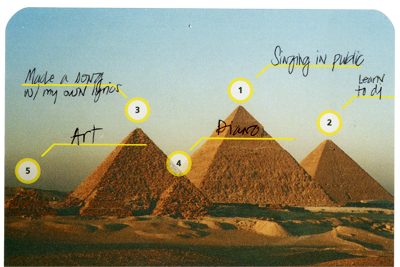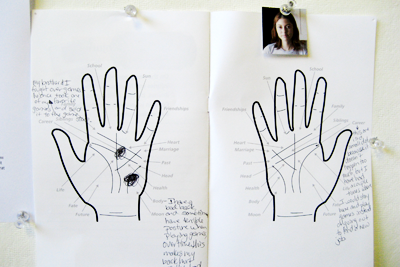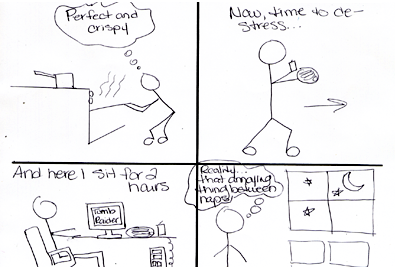Project and
Methods:
Probes:
Evocative probes:
Blank scenarios, Accomplishment cards,
Palm readings and evocation
 Detail from a completed accomplishment card probe return.
Detail from a completed accomplishment card probe return.
 History of gaming injuries. The limited room allowed to feel like they could share some details but needed tell too much if a memory was uncomfortable.
History of gaming injuries. The limited room allowed to feel like they could share some details but needed tell too much if a memory was uncomfortable.

 The blank comics allowed the women to both fill in ready made scenarios and create their own. Here the the respondent showing us her typical gaming night. Though this information is also retold in the interview, the comic version is more expressive.
The blank comics allowed the women to both fill in ready made scenarios and create their own. Here the the respondent showing us her typical gaming night. Though this information is also retold in the interview, the comic version is more expressive.
History of Game Injuries and Accomplishment Cards where the two most self consciously cultural probe-like. The Accomplishment card sought to explore the women's beliefs and values about their own personal accomplishments. Each received three cards with images of a Mount Everest climbing path, a series of successively larger pyramids in Egypt and the path a parachuter would follow after jumping out of a plane. They are not intentionally disruptive, like mapping your family over a map of heaven and hell. Rather, they represent three subtly different ideas about what accomplishment is. It is not important for those differences to be consciously noted, what is important is that there is a prompt to respond to.
It was unclear to the participants why they received three accomplishment cards. Some only did one and others repeated the same information on all three. The most common returns were generic life milestones. Looking at the cards overall showed little more than what would be expected from people in their twenties. However, as individual records of what each woman valued, they were more useful. It is highly suggestive that one person is proud of "straight A's in high school" while another is proud of "making the dance team", and another of being the "team captain." The accomplishment cards became a grounding of not what each woman had done, but rather what they valued.
History of Game Injuries asks women to map their injuries over a diagram of two palms, labeled with aspects of their lives, i.e. school, work, family, as well as abstract ideas like the sun and moon. The women are presented with a choice to label hands literally with where they have hurt their hands playing games or metaphorically where they have harmed their lives.
The most productive outcome of the injuries probe was its ability to allow participants to touch on potentially painful memories without needing to speak about them at length. While they were asked to write a description, very little space was provided to do so. This probe's ability to be taken seriously or comically, allowed the women to interact with it on their own terms. It was included along with a journal for recording game memories. Together they proved to encourage reflection in the women about their gamming practices.
A common outcome in the research phase of Super Studio classes are the creation of scenarios--a moment by moment description of a persona moving through an event. As an inversion of the typical process of research--> findings--> outcomes (like scenarios) blank scenario comics were designed. These stick figure comics, in which things seemed to happen but the details are missing (and the voice bubbles blank) elicit or encourage ambiguous and playful responses. What the participants returned may describe a situation that is common or unique, real or imagined, desirable or unwanted.
Through looking at the interviews it became clear how the stories in the blank comics operated (wishful, documentary, historically, etc.) What the scenarios showed the most clearly were fantasies. Power fantasies of getting the upper hand at the game store or beating a friend at a game. Or wishful fantasies of having a group of friends over to play. While many of the stories told through the comics were also told in the interview, the comics allowed the women to tell them in much more charming, expressive, and funny ways. All the women were given one comic of blank frames. Some women filled these in copying the simple stick figure motif of the other comics. They took the language of the other comics and ran with it. If the comics had grater detailing this would not have been possible.